Papers by George Papanikolaou
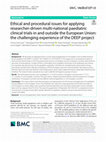
BMC Medical Ethics, 2021
Background We describe our experience from a multi-national application of a European Union-funde... more Background We describe our experience from a multi-national application of a European Union-funded research-driven paediatric trial (DEEP-2, EudraCT 2012-000353-31; NCT01825512). This paper aims to evaluate the impact of the local and national rules on the trial authorisation process in European and non-European countries. National/local provisions and procedures, number of Ethics Committees and Competent Authorities to be addressed, documentation required, special provisions for the paediatric population, timelines for completing the authorisation process and queries received were collected; compliance with the European provisions were evaluated. Descriptive analysis, Wilcoxon Rank-Sum test and General Linear Model analysis were used to determine factors potentially influencing the timelines. The Cluster Analysis procedure was used to identify homogenous groups of cases. Result The authorisation process was completed in 7.7 to 53.8 months in European countries and in 17.1 to 27.1 m...
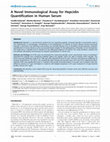
PLoS ONE, 2009
Background: Hepcidin is a 25-aminoacid cysteine-rich iron regulating peptide. Increased hepcidin ... more Background: Hepcidin is a 25-aminoacid cysteine-rich iron regulating peptide. Increased hepcidin concentrations lead to iron sequestration in macrophages, contributing to the pathogenesis of anaemia of chronic disease whereas decreased hepcidin is observed in iron deficiency and primary iron overload diseases such as hereditary hemochromatosis. Hepcidin quantification in human blood or urine may provide further insights for the pathogenesis of disorders of iron homeostasis and might prove a valuable tool for clinicians for the differential diagnosis of anaemia. This study describes a specific and non-operator demanding immunoassay for hepcidin quantification in human sera. Methods and Findings: An ELISA assay was developed for measuring hepcidin serum concentration using a recombinant hepcidin25-His peptide and a polyclonal antibody against this peptide, which was able to identify native hepcidin. The ELISA assay had a detection range of 10-1500 mg/L and a detection limit of 5.4 mg/L. The intra-and interassay coefficients of variance ranged from 8-15% and 5-16%, respectively. Mean linearity and recovery were 101% and 107%, respectively. Mean hepcidin levels were significantly lower in 7 patients with juvenile hemochromatosis (12.8 mg/L) and 10 patients with iron deficiency anemia (15.7 mg/L) and higher in 7 patients with Hodgkin lymphoma (116.7 mg/L) compared to 32 age-matched healthy controls (42.7 mg/L). Conclusions: We describe a new simple ELISA assay for measuring hepcidin in human serum with sufficient accuracy and reproducibility.
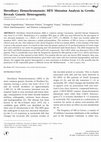
Blood Cells, Molecules, and Diseases, 2000
Hereditary hemochromatosis (HH) is common among Caucasians; reported disease frequencies vary fro... more Hereditary hemochromatosis (HH) is common among Caucasians; reported disease frequencies vary from 0.3 to 0.8%. Identification of a candidate HFE gene in 1996 was soon followed by the description of two ancestral mutations, i.e., c.845G3 A (C282Y) and c.187C3 G (H63D). To these was recently added the mutation S65C, which may represent a simple polymorphism. The incidence of HH in Greece is unknown but clinical cases are rare. Also unknown is the carrier frequency of the two mutant alleles. A first estimate of the latter is given in the present report. It is based on data from the genetic analysis of 10 unrelated patients of Greek origin who were referred to our center for genotyping and 158 unselected male blood donors. The allele frequencies for the C282Y and H63D mutations were 0.003 and 0.145, respectively. The C282Y allele was detected in 50% of HH patients. This is considerably lower than the frequencies reported for HH patients in the U.S.A. (82%) and France (91%) and closer to that reported in Italy (64%). Five patients did not carry any known HFE mutation; three may represent cases of juvenile hemochromatosis, given their early onset with iron overload, hypogonadism, and heart disease. We suggest that genetic heterogeneity is more prominent in Southern Europe. It is also possible that the penetrance of the responsible genes is different across the Mediterranean.
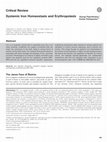
IUBMB life, Jun 6, 2017
Iron is an essential nutrient that is potentially toxic due to its redox reactivity. Insufficient... more Iron is an essential nutrient that is potentially toxic due to its redox reactivity. Insufficient iron supply to erythroid cells, the major iron consumers in the body, leads to various forms of anemia. On the other hand, iron overload (hemochromatosis) is associated with tissue damage and diseases of liver, pancreas, and heart. Physiological iron balance is tightly controlled at the cellular and systemic level by iron regulatory proteins (IRP1, IRP2) and the iron regulatory hormone hepcidin, respectively. Underlying mechanisms often intersect to achieve optimal iron utilization, to control immune responses, and to prevent iron toxicity. This review focuses on systemic iron homeostasis in the context of erythropoiesis, a highly iron-demanding process. We discuss the function and regulation of hepcidin by various stimuli, and highlight hepcidin-dependent and -independent mechanisms that link iron utilization with maturation of erythroid progenitor cells. © 2017 IUBMB Life, 2017.
Haematologica, 2004
Mutations of the HJV gene, which maps on chromosome 1q21, underlie most cases of juvenile hemochr... more Mutations of the HJV gene, which maps on chromosome 1q21, underlie most cases of juvenile hemochromatosis. We evaluated the frequency of the most common mutation (G320V) of the HJV gene in the Greek population, since 50% of cases of hereditary hemochromatosis in Greece carry mutations of the HJV gene.
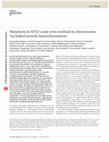
Nature Genetics, 2003
Juvenile hemochromatosis is an early-onset autosomal recessive disorder of iron overload resultin... more Juvenile hemochromatosis is an early-onset autosomal recessive disorder of iron overload resulting in cardiomyopathy, diabetes and hypogonadism that presents in the teens and early 20s (refs. 1,2). Juvenile hemochromatosis has previously been linked to the centromeric region of chromosome 1q (refs. 3-6), a region that is incomplete in the human genome assembly. Here we report the positional cloning of the locus associated with juvenile hemochromatosis and the identification of a new gene crucial to iron metabolism. We finely mapped the recombinant interval in families of Greek descent and identified multiple deleterious mutations in a transcription unit of previously unknown function (LOC148738), now called HFE2, whose protein product we call hemojuvelin. Analysis of Greek, Canadian and French families indicated that one mutation, the amino acid substitution G320V, was observed in all three populations and accounted for twothirds of the mutations found. HFE2 transcript expression was restricted to liver, heart and skeletal muscle, similar to that of hepcidin, a key protein implicated in iron metabolism 7-9. Urinary hepcidin levels were depressed in individuals with juvenile hemochromatosis, suggesting that hemojuvelin is probably not the hepcidin receptor. Rather, HFE2 seems to modulate hepcidin expression.
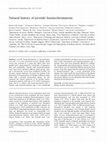
British Journal of Haematology, 2002
Summary. Juvenile haemochromatosis or haemochromatosis type 2 is a rare autosomal recessive disor... more Summary. Juvenile haemochromatosis or haemochromatosis type 2 is a rare autosomal recessive disorder which causes iron overload at a young age, affects both sexes equally and is characterized by a prevalence of hypogonadism and cardiopathy. Patients with haemochromatosis type 2 have been reported in different ethnic groups. Linkage to chromosome 1q has been established recently, but the gene remains unknown. We report the analysis of the phenotype of 29 patients from 20 families of different ethnic origin with a juvenile 1q‐associated disease. We also compared the clinical expression of 26 juvenile haemochromatosis patients with that of 93 C282Y homozygous males and of 11 subjects with haemochromatosis type 3. Patients with haemochromatosis type 2 were statistically younger at presentation and had a more severe iron burden than C282Y homozygotes and haemochromatosis type 3 patients. They were more frequently affected by cardiopathy, hypogonadism and reduced glucose tolerance. In con...
Blood Cells, Molecules, and Diseases, 2002
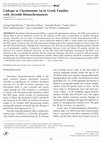
Blood Cells, Molecules, and Diseases, 2001
Hereditary hemochromatosis (HH) is a genetically heterogeneous disease. The HFE gene resides on c... more Hereditary hemochromatosis (HH) is a genetically heterogeneous disease. The HFE gene resides on chromosome 6 and its mutations account for the majority of HH cases in populations of northern European ancestry. Recently, two new types of hemochromatosis have been identified: Juvenile hemochromatosis (JH or HFE2), which maps to chromosome 1q21, and an adult form defined as HFE 3, which results from mutations of the TFR 2 gene, located at 7q22. We have performed a linkage study in five unrelated families of Greek origin with non-HFE hemochromatosis. Linkage at the chromosome 1q21 JH locus was detected in affected members with the use of polymorphic markers. Comparison of haplotypes between Greek and Italian JH patients revealed the presence of a common haplotype. However, the fact that many other haplotypes carrying the JH defect were observed in the two populations indicates that the respective mutations may have occurred in different genetic backgrounds. We suggest that hemochromatosis patients without HFE mutations should be evaluated for other possible types of hemochromatosis since hemochromatosis type 3 (HFE3) has a clinical appearance similar to HFE 1, and JH may have a late onset in some cases.
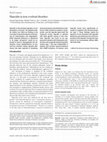
Blood, 2005
Hepcidin is the principal regulator of iron absorption in humans. The peptide inhibits cellular i... more Hepcidin is the principal regulator of iron absorption in humans. The peptide inhibits cellular iron efflux by binding to the iron export channel ferroportin and inducing its internalization and degradation. Either hepcidin deficiency or alterations in its target, ferroportin, would be expected to result in dysregulated iron absorption, tissue maldistribution of iron, and iron overload. Indeed, hepcidin deficiency has been reported in hereditary hemochromatosis and attributed to mutations in HFE, transferrin receptor 2, hemojuvelin, and the hepcidin gene itself. We measured urinary hepcidin in patients with other genetic causes of iron overload. Hepcidin was found to be suppressed in patients with thalassemia syndromes and congenital dyserythropoietic anemia type 1 and was undetectable in patients with juvenile hemochromatosis with HAMP mutations. Of interest, urine hepcidin levels were significantly elevated in 2 patients with hemochromatosis type 4. These findings extend the spect...
Arthritis & Rheumatism, 2003
ObjectiveTo evaluate whether arthropathy is associated with juvenile hemochromatosis and, if so, ... more ObjectiveTo evaluate whether arthropathy is associated with juvenile hemochromatosis and, if so, to assess the relationship between this feature and other clinical features of the disease.MethodsClinical, laboratory, and radiologic evidence of arthropathy was studied in 8 Greek patients with genetically proven juvenile hemochromatosis. Osteopenia and osteoporosis were assessed by bone mineral density measurement.ResultsSeven of the 8 patients had articular manifestations. The main affected joint was the metacarpophalangeal joint, and the arthritis was progressive independent of phlebotomy therapy. Osteopenia was observed in 2 patients, and osteoporosis in 2 patients.ConclusionArthropathy may be present in patients with juvenile hemochromatosis, with features similar to those found in patients with hemochromatosis type 1.
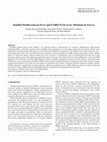
International Journal of Hematology, 2005
Familial Mediterranean fever (FMF) is an inherited disease characterized by recurrent inflammator... more Familial Mediterranean fever (FMF) is an inherited disease characterized by recurrent inflammatory polyserositis. Although FMF is classically expected only in Middle East populations, it is becoming evident that the disease affects more groups than initially thought. The disease is associated with a number of mutations of the MEFV gene, which codes for a protein named pyrin. The role of E148Q pyrin gene mutation in the development of FMF remains inconclusive. Some authors believe it causes the disease, whereas others favor the concept of a noncausative role. To understand better the role of this mutation, gathering data from different populations may be of value. We studied 60 Greek cases fulfilling the criteria for FMF diagnosis, 30 cases being a definite FMF diagnosis and 30 a probable diagnosis. Twenty-one of the patients, carried mutation E148Q. One was a homozygote (E148Q/E148Q), and 20 carried mutation E148Q in combination with other mutations (compound heterozygotes). In 6 of the 60 cases studied, no mutations were found. Compared with the results for healthy controls, E148Q mutation is significantly frequent. Because different populations may exhibit different patterns of pyrin mutations, association of the E148Q mutation with FMF should be considered in connection with origin data.











Uploads
Papers by George Papanikolaou